What to Wear Hiking: A Women’s Guide to Outdoor Apparel
Wondering what to wear hiking? In this post, I share the best hiking clothes that I wear in some combination on every single hiking or backpacking trip I go on.
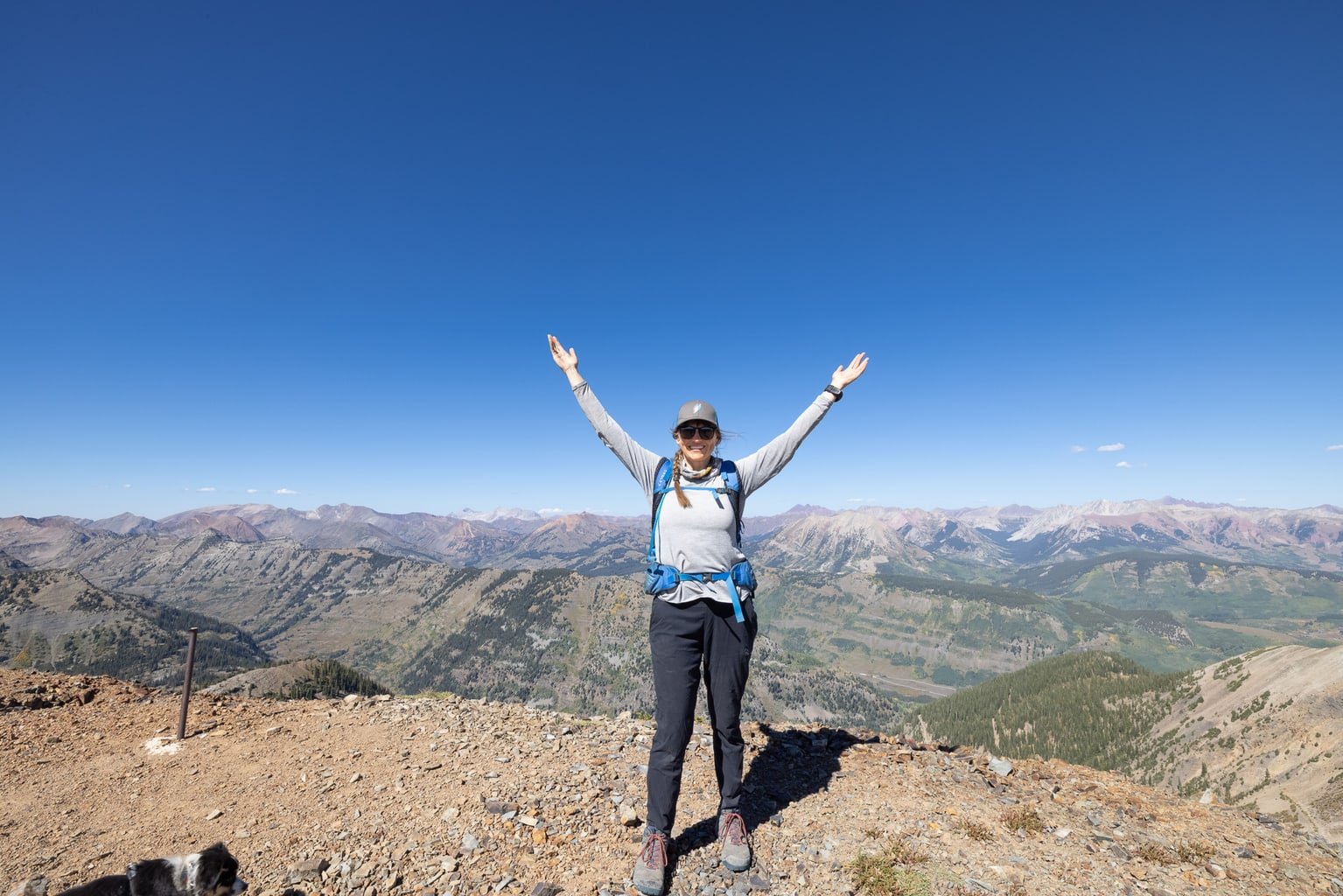
One of the most common questions I get about spending time outside is what to wear hiking. What do you need to wear to stay comfortable, dry, and safe on the trail?
Technically, hiking doesn’t require any special clothing. If you are new to hiking and starting out on short, simple trails, I recommend just dressing in the clothes that you already have. The key is to dress in layers, though, so you can add or subtract clothing as your temperature changes.
Once you start to advance to more challenging conditions and terrain, however, your hiking outfit can be the difference between having fun and being uncomfortable (and possibly unsafe) – whether that be too hot, too cold, or too wet.
I have a lot of experience hiking and backpacking and in this post, I share tips on how to dress for hikes plus some of my favorite hiking clothes that I wear time and again.
3 Quick Tips on What to Wear Hiking
1. Dress in layers
Dressing in layers is one of the best things you can do when gearing up for a hike. Layering your clothes makes it easy to add or shed pieces depending on temperature changes or how strenuous the hike is.
Layering your top half
Most of our heat is generated from our core, so it’s important to layer our top half based on the temperatures and conditions. Here is how I think about layering up when I head out for a hike:
Carry your layers in a daypack
If I know I’ll be adding or shedding layers throughout my hike, I like to carry a daypack so I can easily stash them when not needed.
Layering your bottom half
Depending on how cold or rainy it is, you may or may not need to layer your bottom half. I like to hike in leggings, so those are typically my next-to-skin layer. If it’s rainy, I’ll wear some lightweight rain pants over them and if it’s cold, I’ll swap my leggings for some thermal tights.
If you’ll be hiking in winter, be sure to check out my tips on cold-weather layering basics.
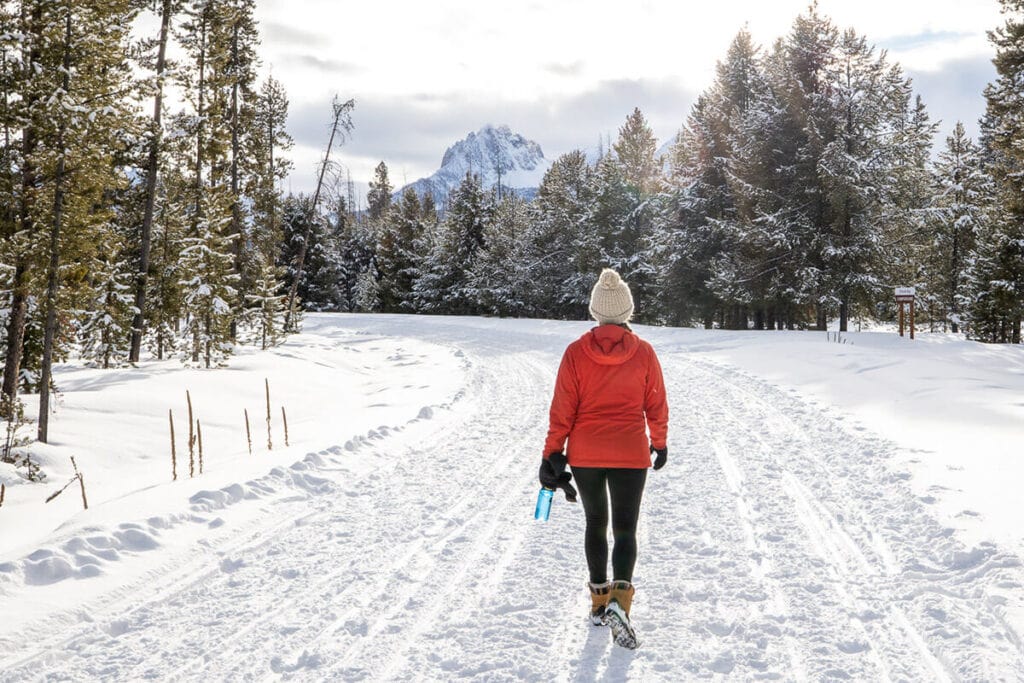
2. Choose synthetic materials
Ideally, hiking clothes should be made of moisture-wicking materials that are quick-drying. Cotton is not a good choice for hiking because it doesn’t dry quickly and can leave you feeling chilled when wet.
Synthetic materials like nylon and polyester (ideally made from recycled materials) are better choices because they wick away moisture and are breathable.
3. Dress for different seasons
What you choose to wear hiking should change based on the season.
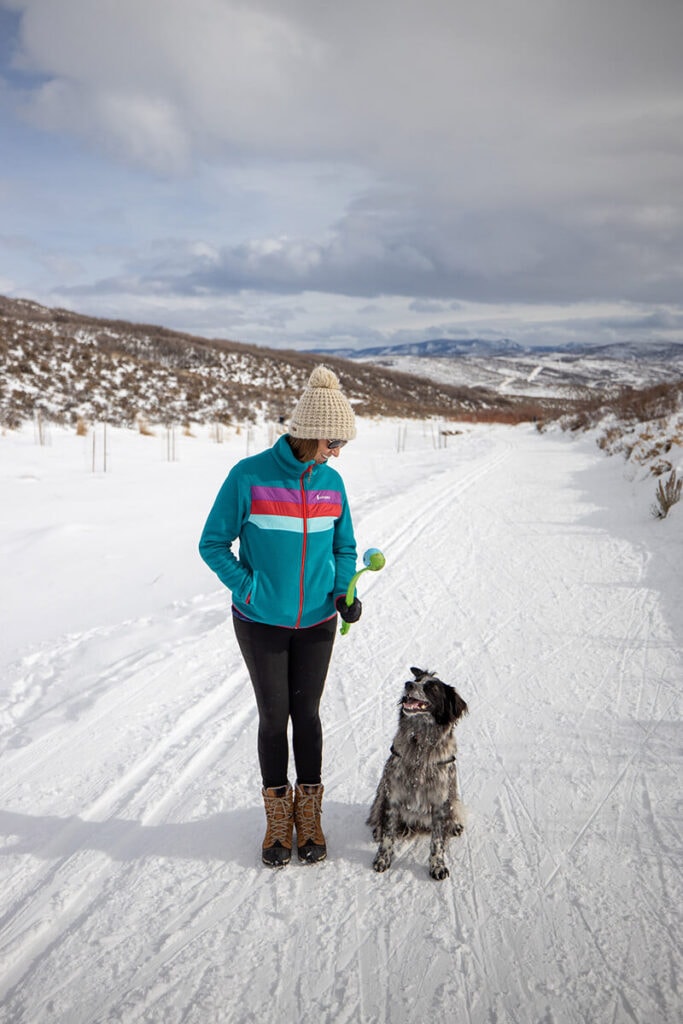


Hiking Shirts & Tops
As I mentioned above, most of our heat is generated and regulated in our core, so it’s important to choose our hiking shirts and tops carefully.
When I’m shopping for new hiking tops I make sure that they are:
Moisture-Wicking Hiking Tee
For hiking, I like to have a few moisture-wicking, breathable short-sleeved tees and the Patagonia Cool Capilene T-Shirt is my favorite.
It provides 50+ UPF sun protection, so it’s great for sunny hikes and it’s made from a lightweight, moisture-wicking material so it keeps me dry and cool no matter the day. I also love that it’s designed with a flattering cut and doesn’t cling to my body.
I have these tees in several colors and pretty much live in them during summer. Also, since I travel in my van, I look for clothing that can be worn several times before it really needs to be washed, and these shirts meet the mark.
My only suggestion is to choose bolder colors over lighter colors since the lighter colors show dirt more.
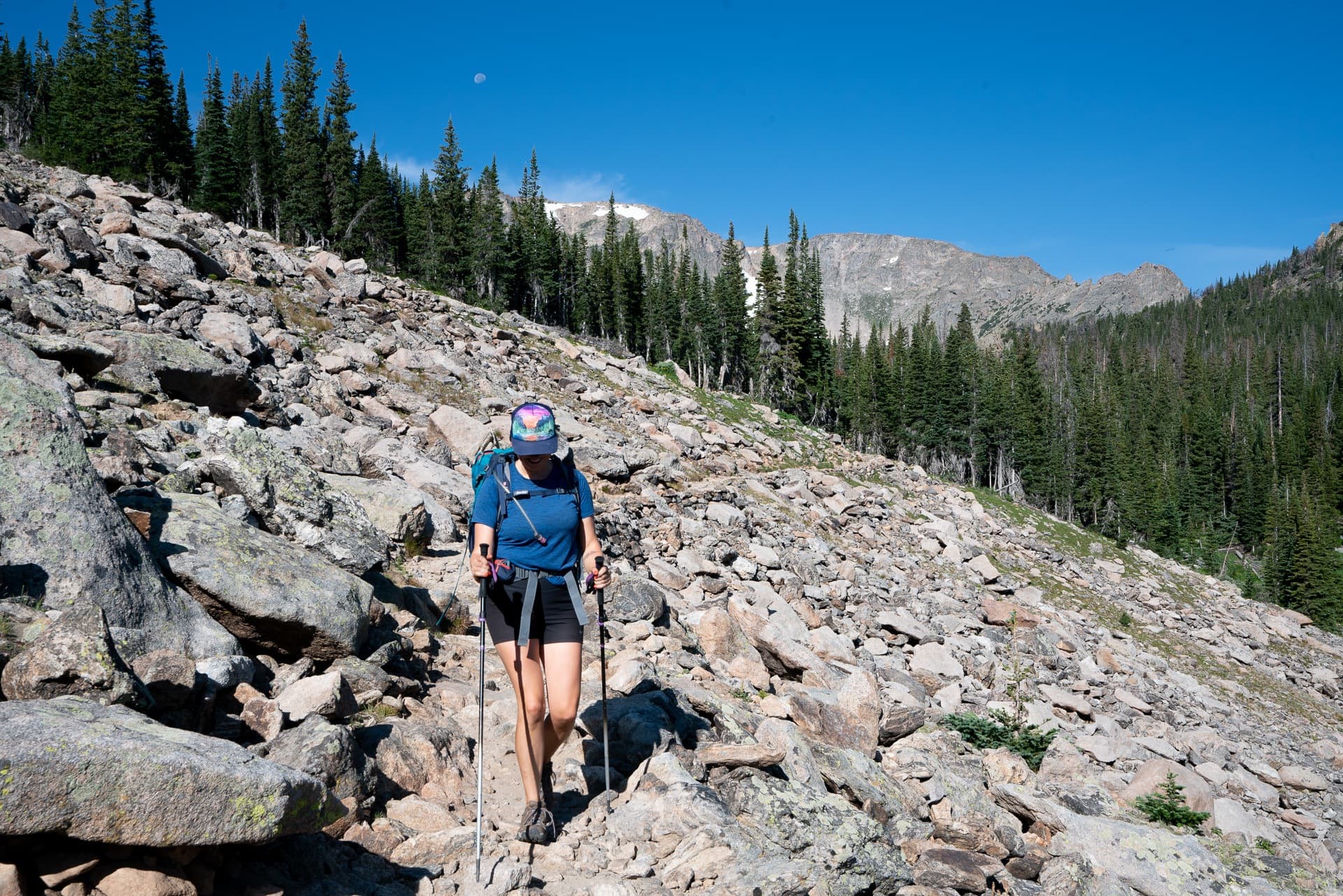
The Patagonia Cool Capilene shirt is also available as a long-sleeved option. Lately, I’ve been choosing the long-sleeve version in order to protect my skin from the sun, especially when hiking at altitude. Even with long sleeves, it breathes well and never leaves me feeling too sweaty.
Read next: Best Sun Protection Shirts for Women
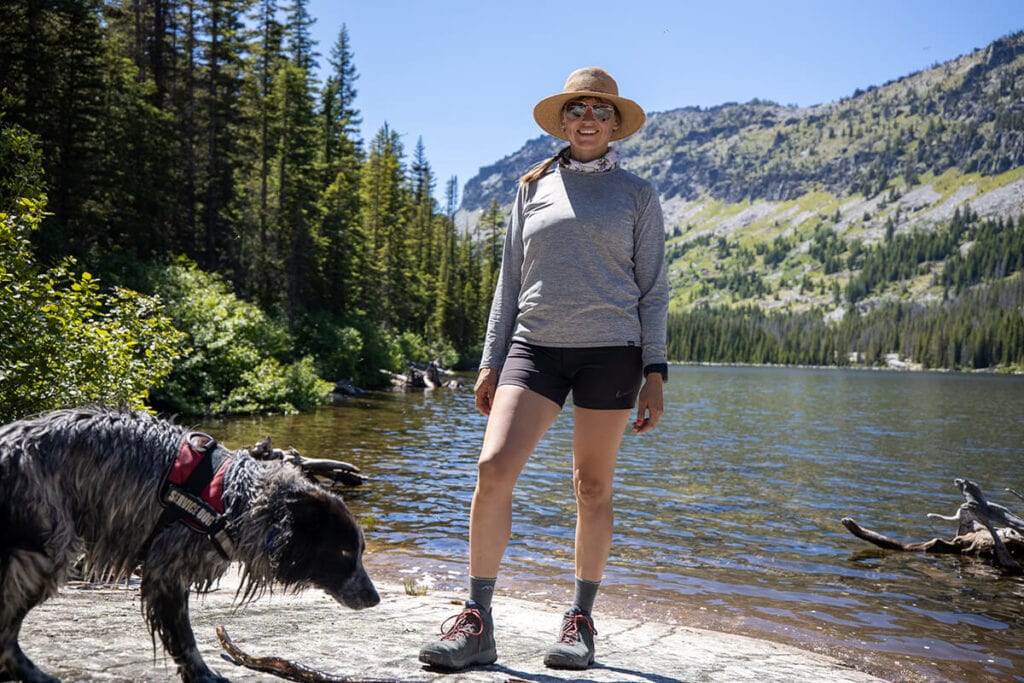
Mid-Weight Long Sleeve Layer
As I talked about in the first section, layering clothes is important to stay warm in changing conditions. If the weather takes a turn for the worse or you’re out longer than you think you’ll be and the temperatures start to drop, you’ll be happy to have a midweight baselayer with you.
One of my go-to choices for a mid-weight hiking base layer is the Patagonia Capilene Thermal Zip-neck. Maybe you’re seeing a trend here, but I like Patagonia apparel because of their environmentally friendly practices (this shirt is made from 50-100% recycled content).
This top is warm, yet breathes it well and because of how small it packs down, I almost always bring this hiking and backpacking. I also wear it to bed on camping trips.
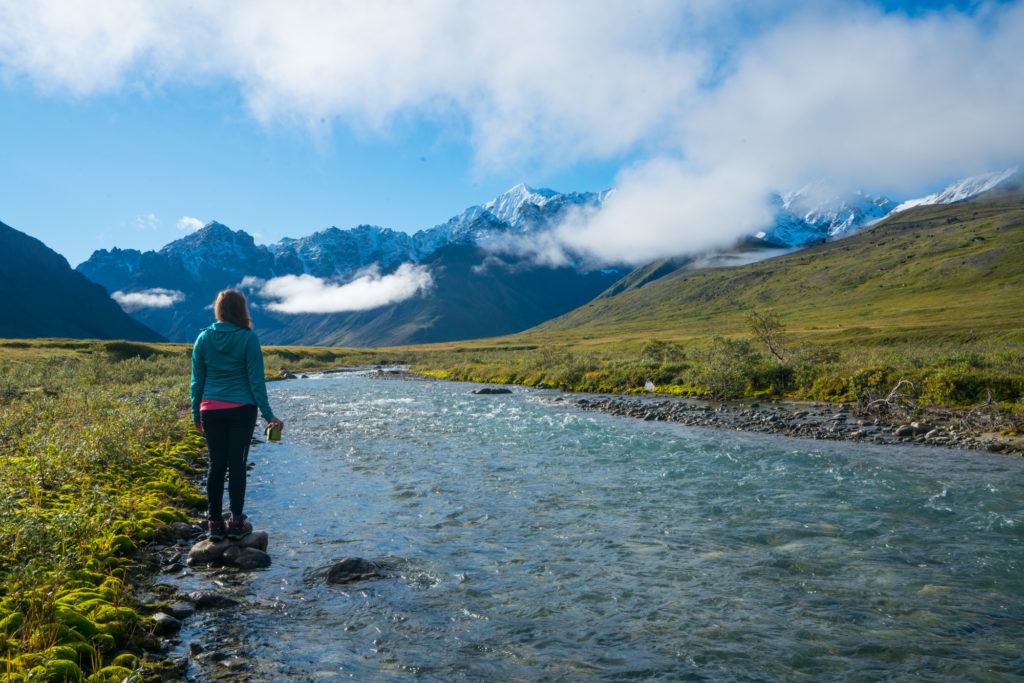
Some outdoor women prefer wool for warmer layers. Made from sustainable merino wool, this Icebreaker 200 Half-Zip baselayer is incredibly soft and provides excellent warmth even on cold days.
It is pricey, but this is one of the more durable wool layers I own and also serves as a functional layer for winter sports as well. I wear the crewneck version of this top every single day when I ski.
Hiking Jackets
Whether you choose a heavier insulated jacket or a lighter-weight jacket for your hike depends on the season and the climate you are hiking in.
Here are my top picks for hiking jackets:
Heavy Insulated Jacket
If I’m hiking at altitude, during the shoulder season, or if there is a chance of cold temps, I bring my Arc’teryx Atom Insulated Hoody as an outer layer. It feels like you’re wearing a cloud and it’s very warm thanks to the synthetic insulation.
The cut is also flattering (it doesn’t make you look like a marshmallow), and it’s long enough so you don’t get any backdraft.
This is also a great jacket for cold-weather hiking and camping and it also makes an effective and comfortable layer under a ski shell.
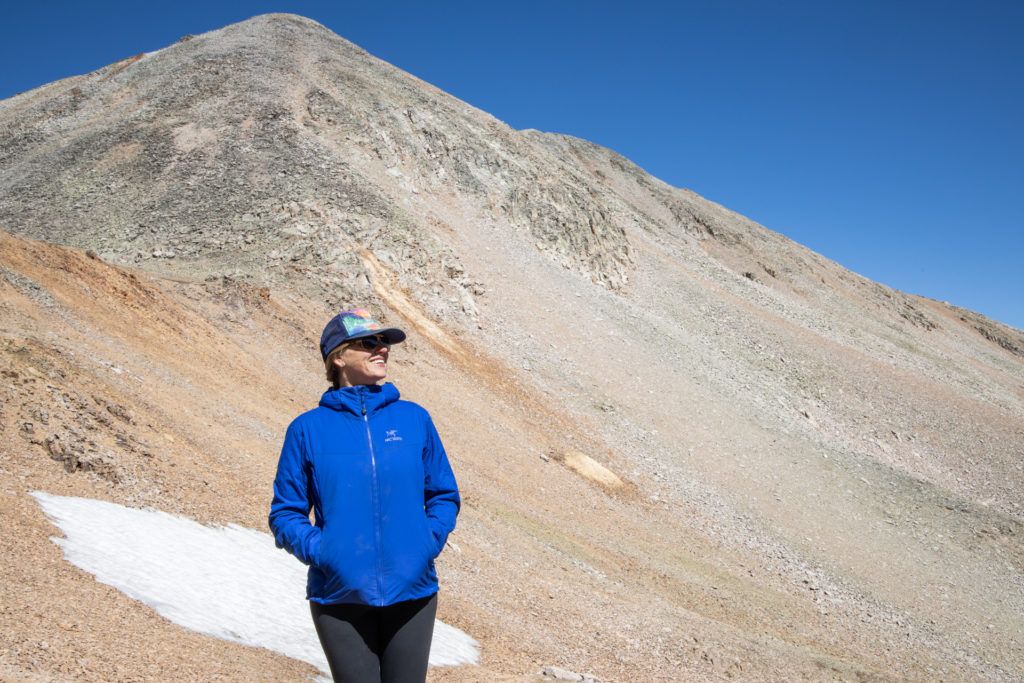
Lightweight Insulated Jacket
If I need a lighter jacket as a “just in case”, the Arc’teryx Kyanite Fleece Hoodie is my go-to. I took this jacket with me to Italy and was really impressed with how it performed on cooler hikes. I layered it on top of my Patagonia Capilene shirt (see above) and it was perfect for cool fall temps.
This jacket is a bit bulkier than other lightweight jackets, but it breaths well so if you have the right layers on underneath, you should be comfortable wearing it throughout your hike.
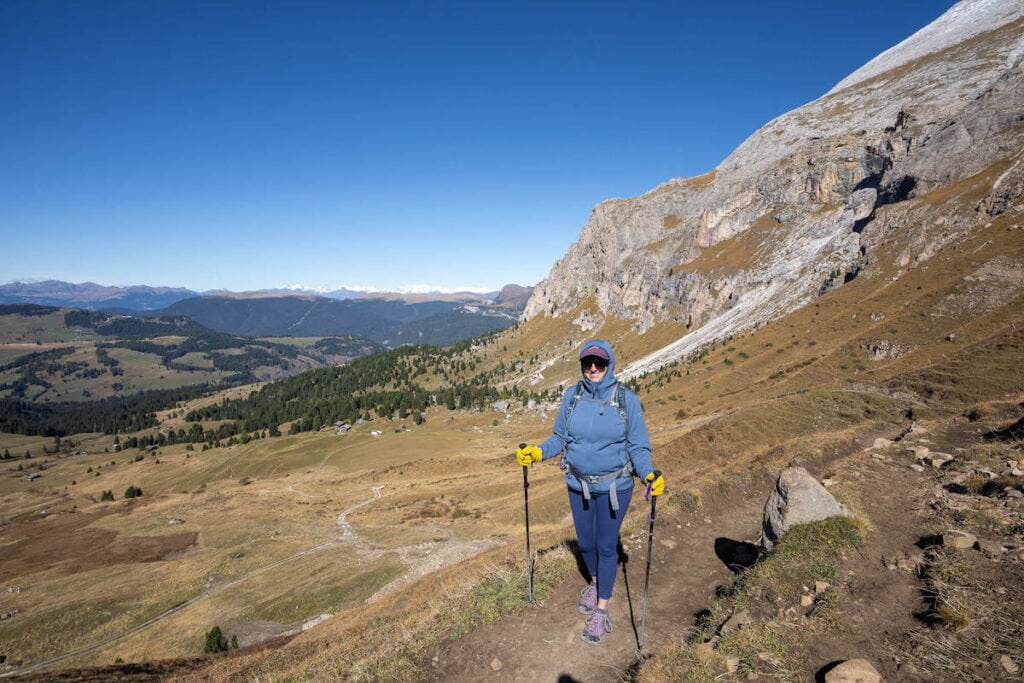
Read next: Looking for more jacket recommendations? Check out our post on the Best Women’s Synthetic Jackets.
Light Windbreaker
The Patagonia Houdini is hands-down the best lightweight windbreaker I’ve tried. This jacket is made for warmer weather where you want some protection from wind or bugs (or even the sun).
It’s also water-resistant and breathable which is great if you’re in a location prone to periodic light rain, but don’t trust it as a rain jacket. A traditional Gore-Tex rain jacket (see below) is important if you’re hiking in an area prone to lots of rain.
The Houdini only weighs 3.4 ounces, so it’s really a no-brainer to throw in your pack if you’re hiking in an exposed area.
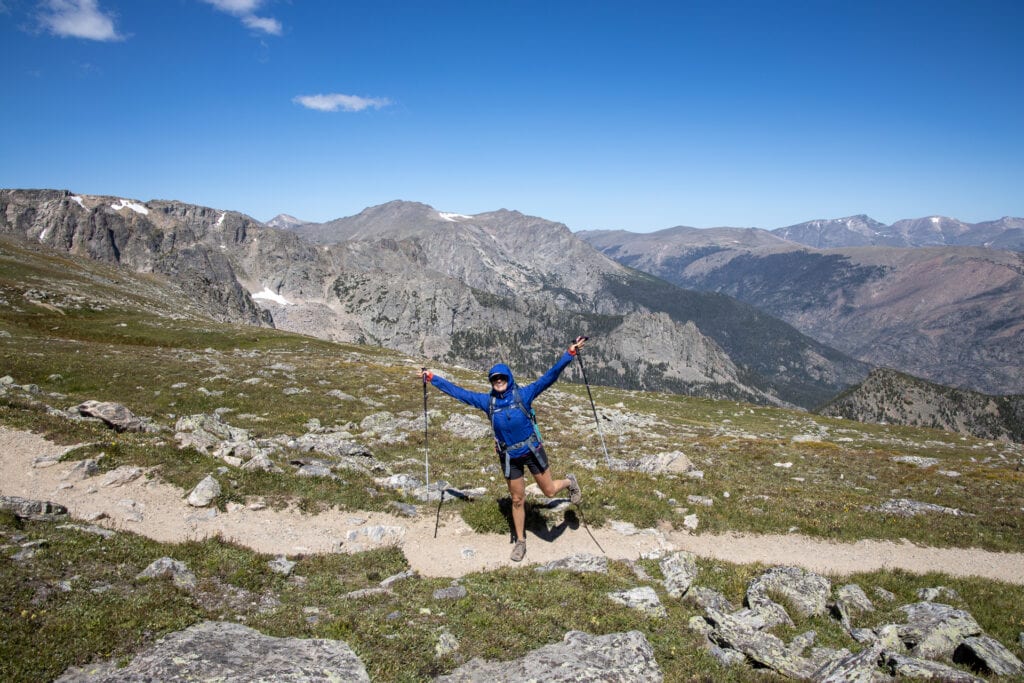
Women’s Hiking Shorts
Any old shorts will do for hiking as long as they are comfortable.
I personally like hiking in spandex/yoga shorts because they provide the most mobility and there is no loose fabric that can get caught on branches or other obstacles on the trail. Look for ones with pockets!
Legging Shorts
Lately, my go-to legging-style shorts have been the lululemon Wundertrain 6″ High Rise Shorts. They also come in a 4″ and 8″ length depending on your preferences and height.
The waistband stays put, and the material is soft yet thick enough to be durable. I personally prefer all my hiking shorts to be a dark color since you often sit on rocks or the ground when you take breaks, and darker colors don’t get as dirty.

If you’re not a big fan of hiking in spandex or are looking for shorts that are more versatile check out the North Face Aphrodite Shorts. Several of us ladies on the Bearfoot Theory team own and love these!
They have an elastic waistband for comfort and the shorts are loose-fitting but not baggy or saggy. My favorite feature is the pockets. I’m so used to hiking without them in my spandex, I forgot how useful pockets can be. They make it easy to access my phone for photos or to carry my ID and credit card if we were headed to the store.
Finally, the material dries quickly, whether they are wet from a swim or stream crossing.
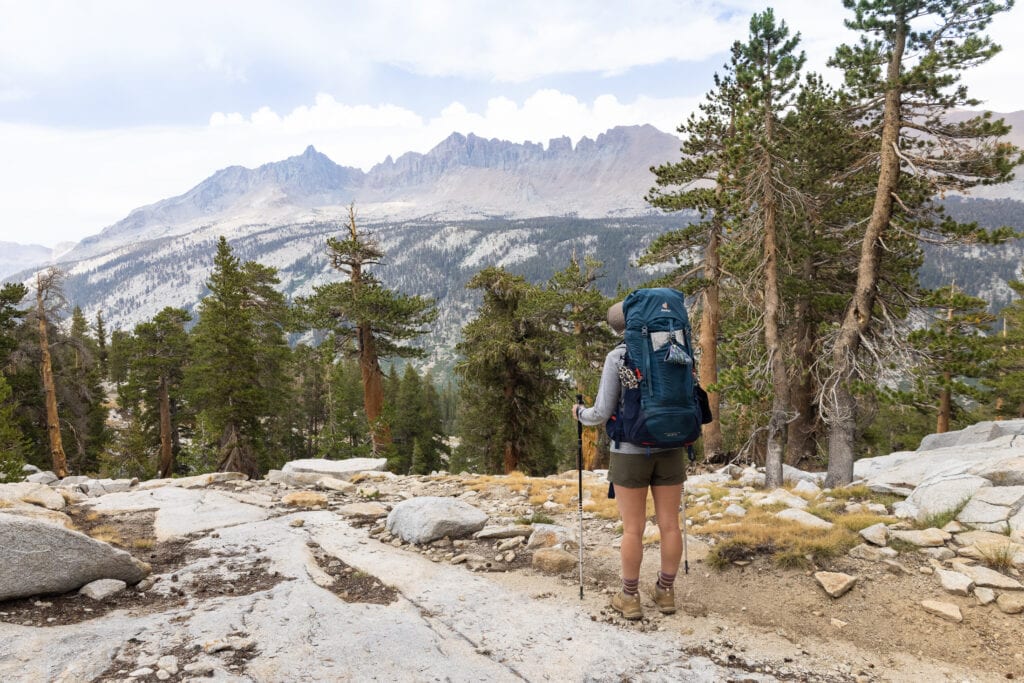
Another great pair to check out is the Patagonia Baggies. These are versatile active shorts that also look cute for walking around town post-hike.
A tried and true favorite, Patagonia Baggies are water-resistant and even have mesh pockets so you can get them wet without having to think twice. They’re also lightweight and stretchy, with an adjustable drawcord.
Read next: Looking for more recommendations? Check out our Women’s Hiking Shorts Gear Guide.
Women’s Hiking Pants
Women’s Hiking Leggings
When it’s cooler, you can probably guess that I swap out my spandex shorts for leggings. Not only are leggings a comfortable and multi-functional piece of clothing, but they’re also super flattering and work well for almost every activity.
I LOVE the lululemon Wundertrain High Rise 25″ tights on warmer days. They are quite breathable so you don’t end up too hot, and they come in lots of fun colors (I personally prefer darker colors since they don’t show dirt as easily).
The ones in the photo below are the 25″ length, but they also come in a 28″ length if you’d prefer them to cover your entire ankle).
These are high-waisted and hit me just above the belly button, and the waistband doesn’t roll over when you move (which is a huge pet peeve of mine with leggings).
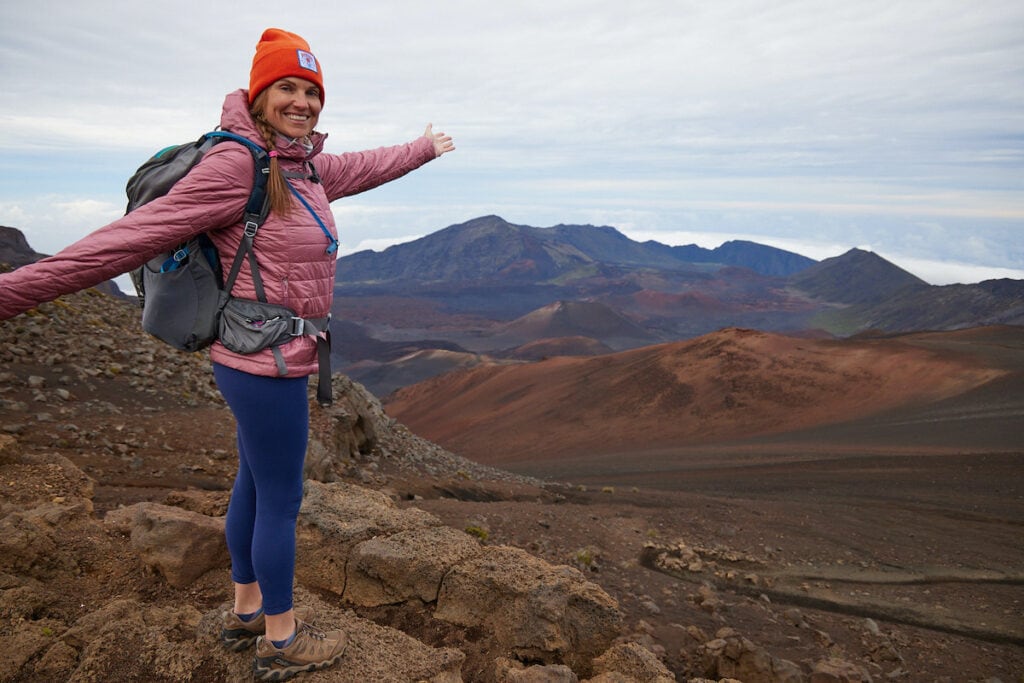
If you don’t like spandex, I recommend these North Face Aphrodite 2.0 Pants, which are cute, stretchy, and lightweight and can be worn on the trail or around town.
I love the elastic waistband which doesn’t dig at all as you hike, and the loose fit means the pants breathe quite well.
For those extra cold days when you need something thicker, these Brooks Momentum Thermal Pants have a thermal layer that insulates on chilly hikes.
The elastic waistband is super comfortable, and they are loose enough to fit another baselayer underneath if it’s really cold.
Read next: Still shopping around? Find more great bottoms over on our Best Women’s Hiking Pants and Leggings blog post.
Hiking Rain Gear
Rain Jacket
The weather in the mountains can be unpredictable and you need to be prepared. Getting wet can not only be uncomfortable, but it can also be dangerous.
If there’s a chance of rain, the REI Co-op Women’s Rainier Rain Jacket is a lightweight (and budget-friendly) rain jacket that will keep you dry if you end up hiking in the rain.
It’s got a fully adjustable hood, vents, and packs down into its own pocket.
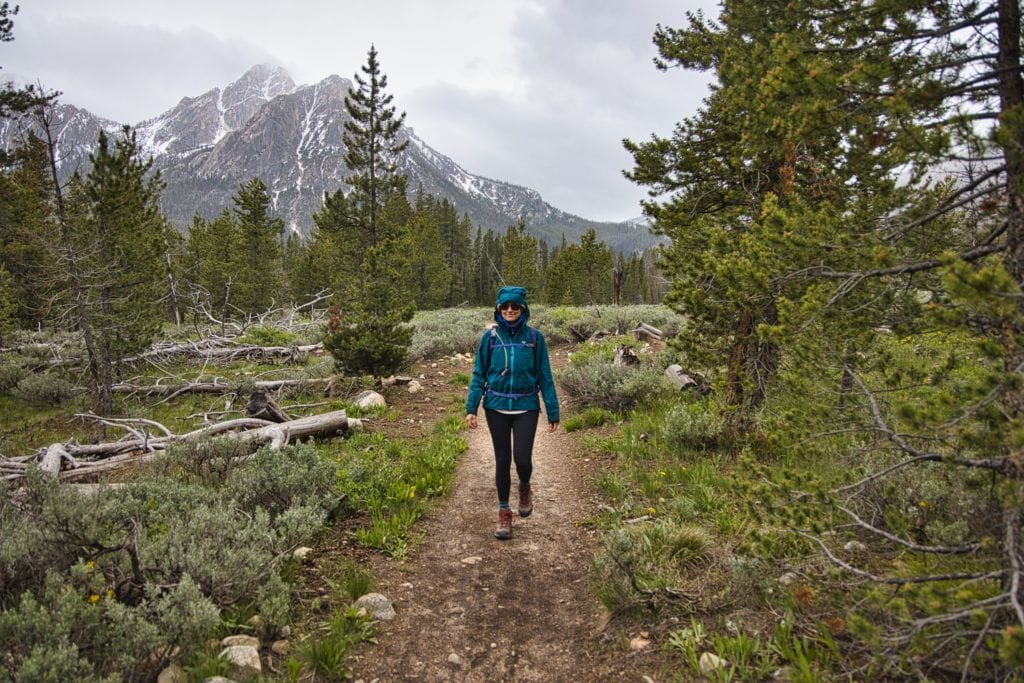
Read next: Head over to our guide to the Best Lightweight Women’s Rain Jackets for Travel and Hiking for more options
Rain Pants
I don’t typically pack rain pants on day hikes unless the forecast predicts a decent amount of rain.
If you are backpacking, however, it’s always a good idea to have a pair of these just in case you get caught in a downpour. These REI Co-op Rainier Rain Pants are great because they are full zip, so you don’t have to take your boots off to get the pants on.
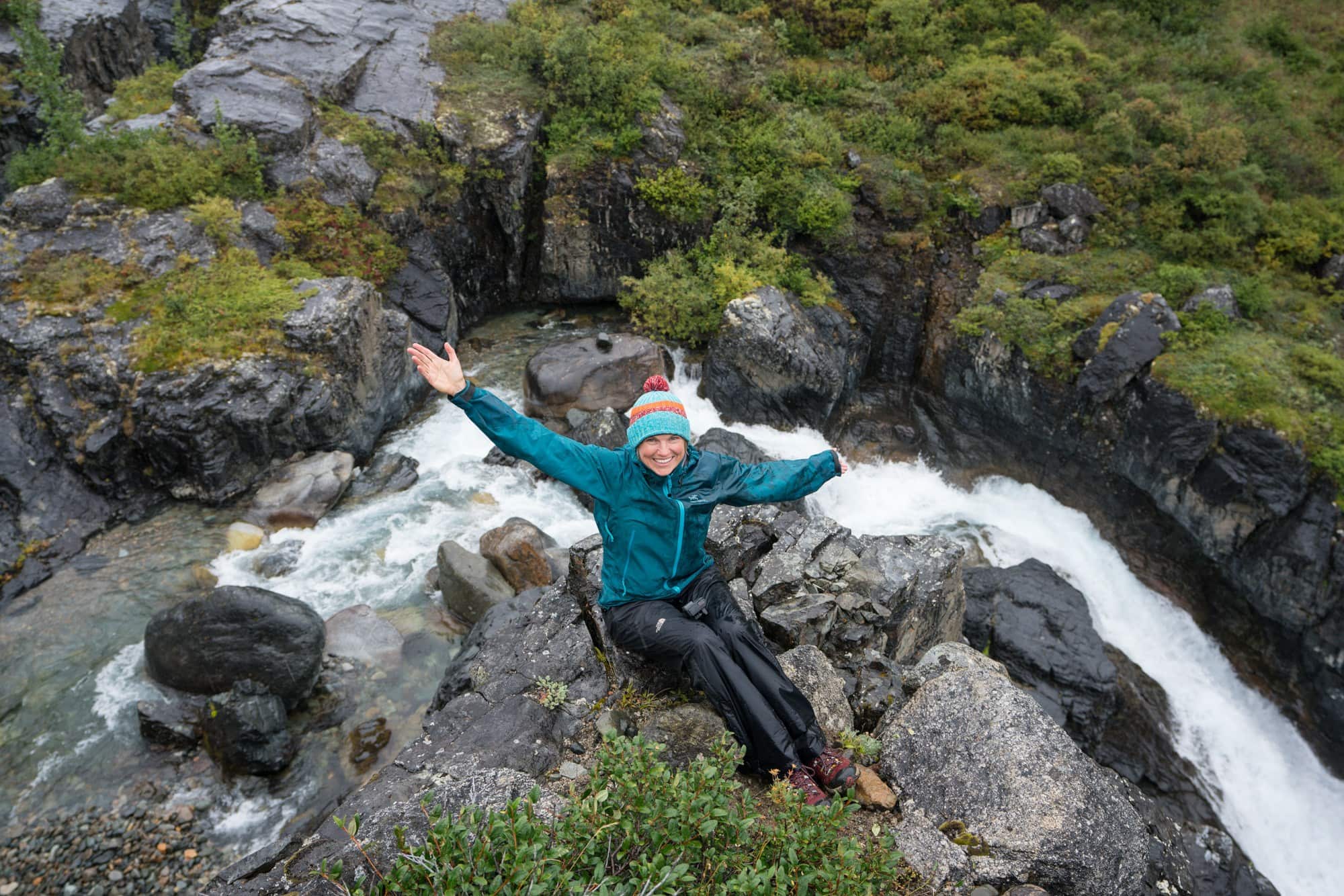
Hiking Undergarments
Sports Bra
Any sports bra that you can move comfortably in and feel supported will work well for hiking.
I personally prefer ones that aren’t too strappy since they are easier to put on. I’m a 36D, and I really love the lululemon All Powered Up Bra for when I want high-impact support.
Another favorite of mine is the Nike Swoosh Bra. It’s got a really simple design, wicks sweat, and can double as a bathing suit when you stumble on that perfect swimming hole.
Quick-Dry Undies
Quick-dry undies are essential for staying cool, dry, odor-free, and clean on the trail, and there are a bunch of options to choose from. I’ve pretty much tried them all.
To be honest, I’ve been pretty disappointed with a lot of underwear I’ve tried. They either shift around, stretch out, or show panty lines.
After testing out literally dozens of pairs, my favorites are the lululemon Invisiwear Boyshorts.
Read next: See our guide to the Best Hiking Underwear for more of our favorites
Hiking Socks
Cotton socks aren’t great on the trail because they slide around and are infamous for causing blisters, so when you are hiking, choose a hiking sock.
Many hiking socks are made with wool which actually helps reduce sweating and keeps the sock snug against your foot to prevent unwanted rubbing.
My preferred hiking socks are made by a company out of Vermont called Darn Tough. They are cushioned in all the right places and over 22 days with these on the John Muir Trail, I didn’t form a single blister.
Darn Tough also uses eco-friendly and sustainable wool, which I love, and they also make some socks without wool, including the CoolMax socks below.
Hiking Footwear
Hiking Shoes
Footwear is arguably one of – if not the most – important gear decisions for hiking. It’s essential to have a good pair of sturdy and comfortable hiking shoes with good traction.
For a low ankle, hiking shoe, I love the Sawtooth X BDry by Oboz, which is lightweight, yet sturdy and waterproof with a grippy bottom that gives you plenty of traction for hikes in all types of conditions and trails.
Hiking Boots
If you prefer a higher ankle boot with a little more support that you can also use for backpacking, then the Oboz Bridger BDry is an excellent shoe with just the right amount of cushion and no break-in period required.
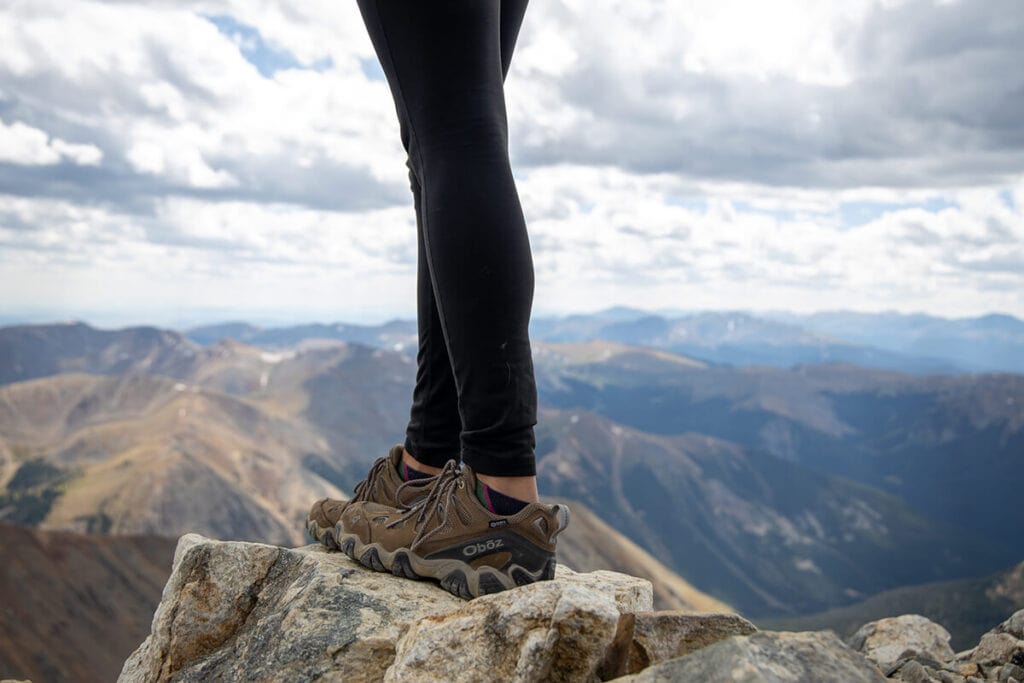
Read next: Find more great hiking shoe options with best women’s hiking boots & shoe guide
Hiking Accessories
Sun Hat
A hat is key for being comfortable when hiking on sunny days – I almost never hike without one.
Really any old hat will work as long as it’s lightweight, comfortable, and protects you from the sun.
I personally like wearing something that provides maximum sun coverage, and my #1 favorite sunhat is the Wallaroo Sedona Hat (Use the code BEARFOOT20 for 20% off).
Alternatively, I’ll hike in a regular baseball cap type of hat, like this Patagonia Trucker Hat.
Read next: Best Women’s Hiking Hats
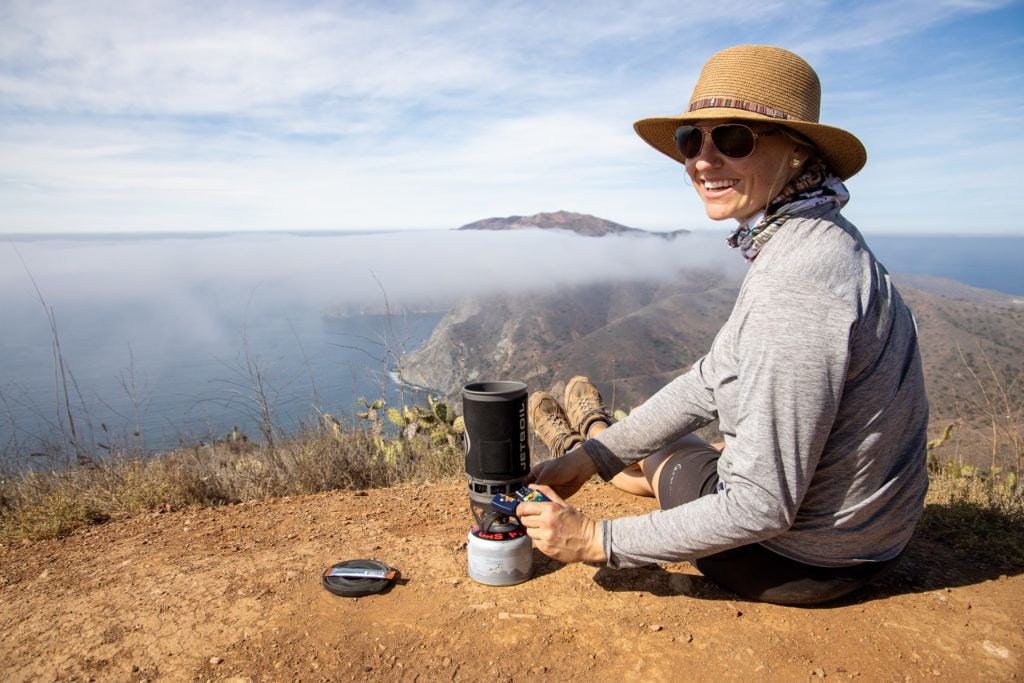
Buff
Ever since I did my Everest Basecamp Trek, I love wearing a Buff when I hike. A Buff provides extra sun protection on your neck, and they can be used to cover your face in the wind.
Sunglasses
Any pair of sunglasses will do, but the pair I’ve been rocking for the last few years are the Oakley Feedback Aviators.
They are lightweight and have no-snag nose pads, which means the nose pads don’t get stuck on your hair! Plus they block 100% of harmful UV rays.
Hiking Day Pack
Don’t forget a daypack to carry your hiking essentials. I like the Osprey Mira 22 Liter Daypack for long day hikes so I can carry lunch, my camera, and extra layers.
Read next: Looking for more daypack options? Check out our blog post on the best women’s daypacks for hiking.
I hope this guide gives you a good idea of what to wear hiking so you can be comfortable and safe on the trail.
READ NEXT
If you have a specific hiking destination in mind, here are some additional packing & gear lists to reference:
Do you have any hiking gear or clothing favorites? Let us know in the comments below!

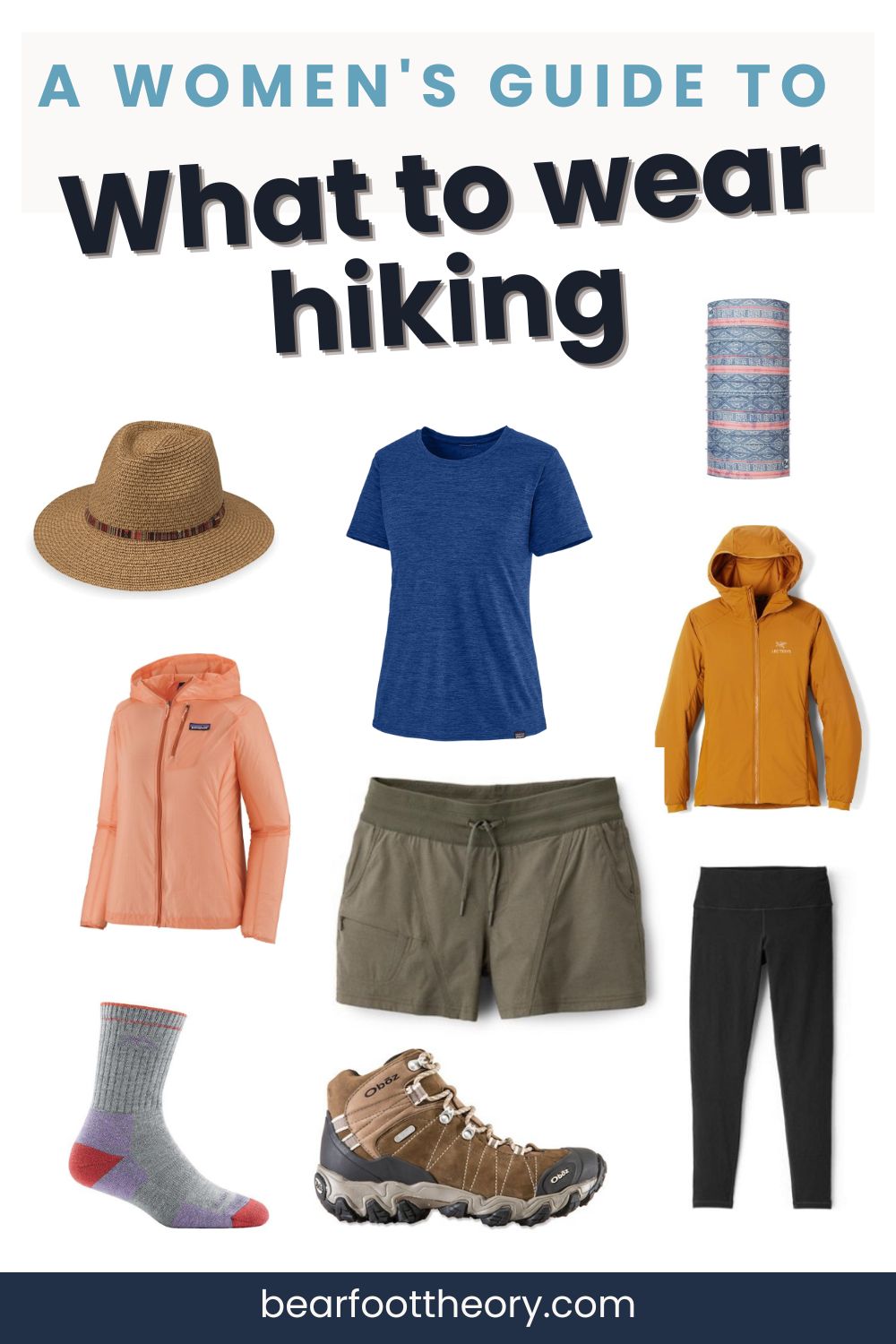
Nice list
Thank you!
Yesss, Darn Tough! So glad to see them getting a shout out…since I found them a few months ago, they’re the only sock I’ll wear running or hiking.
Same. I’m still wearing the two pairs that I took on the John Muir Trail a couple years ago and they are like new.
Thanks for the list! I love your site. I’m preparing for a JMT hike this summer in July and I’m trying to figure out which pants to bring: I have Marmot Lobo convertible hiking pants/shorts, leggings, and the same REI fleece pants you mention. The leggings are a little heavy, so I’m leaning towards leaving them behind, but it just feels strange to not bring leggings along. Thoughts?
Leggings are a must for me. I just got these Arcteryx leggings and I think they are going to be my new go to: http://bit.ly/22gDLDc I haven’t hiked in them yet, but I skied in them the other day and really liked them. I also like these tights by Mountain Hardwear: http://goo.gl/qTLBmx.
If you bring leggings then you can probably swap out the convertible hiking pants for a pair of shorts.
Hi Kristen! This post was super helpful! It looks like the Mountain Hardwear leggings are pretty much sold out everywhere now. Also, the link to the Arcteryx leggings doesn’t seem to go to a specific product. Do you have any recommendations for other leggings/tights? Thanks!!
Ah sorry about that and thanks for letting me know. I’ll update the post now with some new links.
Glad to see that my list matches your almost exactly! Different brands here and there but the same exact list. I’m a big fan of spandex shorts and pants specifically because my thighs touch and having anything baggy at all will leave me pretty chafed. Thanks for sharing!
These are great choices! My pack list is very similar, including the merino long sleeve and same Patagonia Nano Puff. The only thing I would add for those new to hiking/camping: Check out Uniqlo. The Heattech and Airism lines are a great and affordable option for base layers, underwear, etc. I also like their ultra light down vests for another packable layer.
When you did the JMT did you switch out of your boots and wear the Tevas for water crossings? Can’t really imagine hiking with wet shoes/socks! Thanks
It was a very Informative and helpful list but I understand it was mostly directed towards ladies. Leaving aside the socks, boots,rain jacket and down jackets, could you add something specifically for men. I mean with your experience you could easily gather what is popular among competitive male hikers.
This addition would make this a very comprehensive and wholesome piece.
In any case it was a very helpful article. Many thanks to you. And do keep writing your thoughtful and very practical article’s. I have found your blog the best among all others I have read till now.
Thanks and the very best.
i just bought myself the la sportiva nucleo gtx hiking boots and i absolutely love them! a sales person at rei recommended them, after i tried on about 3 pairs at the store. it felt so good after i put them on, they feel so light! i’ve hiked with them at yosemite and i love them!!
Angie, I have a pair of the La Sportiva Nucleo’s as well! Great to hear they are working for you.
Hi ! I just discuvered your blog and I really love it ! I am from France and live in a city close to the montains (Grenoble) and a blog like yours is like my bible ! Keep writting posts with a lot of advises for beginiers and others !
(sorry for the mistakes, I am not used to write in English!)
Thank, Milla, for stopping by!
Thank you for the list!
Great guide dear. Very informative. I recently researched and wrote an article on best hiking shoes for women that are comfortable and stylish. It seems companies out their focus on comfort than how the gear looks. I guess for me as long as the boots are comfy, waterproof and kinda chic, I will be happy.
hello just wondering what month you went in and how cold was it?
Hi Maddy, we hike year-round. Is there a specific trail you are inquiring about?
Merci pour tous les bons conseils!
Reste une question… Je devrai marcher à peu près 25 km par jour pendant 6 semaines sur un terrain de difficulté moyenne à difficile avec des montées et des descentes, dans un climat chaud variant de 10 à 30 degrés.
Je me demande encore si je dois opter pour des souliers de marche avec ou sans GORE-TEX.
Le GORE-TEX me tiendra au sec de l’extérieur en cas de pluie mais rendra mes pieds humides à l’intérieur et donc risque d’ampoules.
Le GORE-TEX est parfait pour l’hiver mais pour l’été, je n’en suis pas si certaine. J’ai l’impression qu’ils seront trop chauds.
Que me conseilles-tu?
Hi Jocelyne, you are right that Gore-Tex might be a bit too hot in the summer. If you’re going to be hiking in a warm climate you might want to consider a more breathable option. Also don’t forget to pack extra socks and change socks frequently. When I hiked the Pacific Crest Trail (20+ miles a day) I often changed my socks at least 3 times a day; this helps keep your feet dry and protects you from blisters.
Hi there
i Work as a mountains guide in morocco atlas mountains i did a lot of treks with a lot of people its very usefull for me what you mentioned in your article thank you very much
In your picture where you are standing by the JM Wilderness Inyo sign – what is hanging off your pack waist belt (orange) and what do you use it for? Thx
Great list!
Totally team hiking leggings! Don’t go without anymore 😀
Nothing else to add besides: I also “wear” natural sunscreen on my skin and self-made lip balm on my lips 😉
You made such an interesting piece to read, giving every subject enlightenment for us to gain knowledge. Thanks for sharing the such information with us to read this…
Hi I also work with tourists, as a mountain guide, and what you write on your article is very useful for me, thank you
Glad you found this helpful 🙂
thank you for this article
Great
jennifer
The hiking Pants on this list are really impressive. I think good hiking apparel shouldn’t sacrifice comfort over functionality and brands like https://coalatree.com/products/trailhead-pants have mastered this and I really love how the quality of products they make because of this!
Hiking is one of the best adventurous sports and I have always wanted to try it with my friends. Thanks for sharing these wonderful insights on clothes required for hiking.
Hello Kristen,
Thank you for the wonderful tips. I have been getting into hiking for the last couple of months, as it is a great activity and I am able to spend more time outside. I still have not bought the whole equipment, as it is an investment and I do not want to spend that much money in one go… Something that I have to invest in, are the shoes… I have been using timberland shoes and impregnated the shoes, for them to be waterproof as I think it is very important, after reading the pros about waterproofing shoes here: https://nano-care.com/products/impregnation/
Do you think the shoes should be higher up in my must buy equipment, or do I get along fine with my Timberland shoes?
Thank you
It really depends on what kind of terrain you’re hiking in. If you’re hiking in wet conditions, a fully waterproof might be worthwhile. But if you’re hiking on mostly dry trails, your Timberlands should be fine. For more info on waterproof vs non-waterproof hiking boots, check out this blog post.
It’s very nice idea to write an article for this topic. I noticed that many people can’t understand about their trekking clothes so i will share this blog with them. I am sure this article will be very helpful to your readers. Keep sharing your ideas!
Great information! Thank you for sharing with us. Keep sharing…